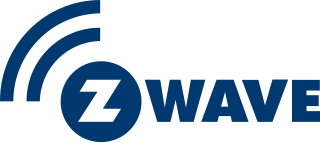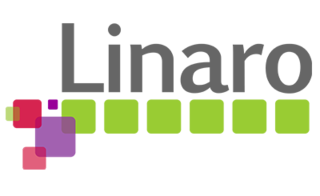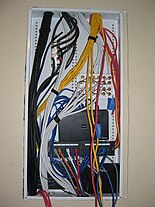Universal Plug and Play (UPnP) is a set of networking protocols that permits networked devices, such as personal computers, printers, Internet gateways, Wi-Fi access points and mobile devices to seamlessly discover each other's presence on the network and establish functional network services. UPnP is intended primarily for residential networks without enterprise-class devices.

Z-Wave is a wireless communications protocol used primarily for residential and commercial building automation. It is a mesh network using low-energy radio waves to communicate from device to device, allowing for wireless control of smart home devices, such as smart lights, security systems, thermostats, sensors, smart door locks, and garage door openers. The Z-Wave brand and technology are owned by Silicon Labs. Over 300 companies involved in this technology are gathered within the Z-Wave Alliance.
Systech Corporation (Systech) is a California corporation founded in 1981 and headquartered in San Diego, California.
A mobile operating system is an operating system for smartphones, tablets, smartwatches, smartglasses, or other non-laptop personal mobile computing devices. While computers such as typical/mobile laptops are "mobile", the operating systems used on them are generally not considered mobile ones, as they were originally designed for desktop computers that historically did not have or need specific mobile features. This line distinguishing mobile and other forms has become blurred in recent years, due to the fact that newer devices have become smaller and more mobile unlike hardware of the past. Key notabilities blurring this line are the introduction of tablet computers and light-weight laptops and the hybridization of the two in 2-in-1 PCs.

GitHub, Inc. is a platform and cloud-based service for software development and version control using Git, allowing developers to store and manage their code. It provides the distributed version control of Git plus access control, bug tracking, software feature requests, task management, continuous integration, and wikis for every project. Headquartered in California, it has been a subsidiary of Microsoft since 2018.
The Internet Protocol for Smart Objects (IPSO) Alliance was an international technical standards organization promoting the Internet Protocol (IP) for what it calls "smart object" communications. The IPSO Alliance was a non-profit organization founded in 2008 with members from technology, communications and energy companies. The Alliance advocated for IP networked devices in energy, consumer, healthcare, and industrial uses. On 27 March 2018, the IPSO Alliance merged with the Open Mobile Alliance (OMA) to form OMA SpecWorks.

Node.js is a cross-platform, open-source server environment that can run on Windows, Linux, Unix, macOS, and more. Node.js is a back-end JavaScript runtime environment, runs on the V8 JavaScript engine, and executes JavaScript code outside a web browser.

Linaro is an engineering organization that works on free and open-source software such as the Linux kernel, the GNU Compiler Collection (GCC), QEMU, power management, graphics and multimedia interfaces for the ARM family of instruction sets and implementations thereof as well as for the Heterogeneous System Architecture (HSA). The company provides a collaborative engineering forum for companies to share engineering resources and funding to solve common problems on ARM software. In addition to Linaro's collaborative engineering forum, Linaro also works with companies on a one-to-one basis through its Services division.
Thread is an IPv6-based, low-power mesh networking technology for Internet of things (IoT) products. The Thread protocol specification is available at no cost; however, this requires agreement and continued adherence to an End-User License Agreement (EULA), which states that "Membership in Thread Group is necessary to implement, practice, and ship Thread technology and Thread Group specifications."
The IoTivity is an open source framework created to standardize inter-device connections for the IoT. Any individual or company can contribute to the project, and this may influence OCF standards indirectly. However, being a member of the OCF can benefit from patent cross-licensing protection.
The Alliance for Open Media (AOMedia) is a non-profit industry consortium that develops open, royalty-free technology for multimedia delivery headquartered in Wakefield, Massachusetts. It uses the ideas and principles of open web standard development to create video standards that can serve as royalty-free alternatives to the hitherto dominant standards of the Moving Picture Experts Group (MPEG) and its related business model of exploiting intellectual property through patent royalties associated with patent and licensing complications and fees.
Zephyr is a small real-time operating system (RTOS) for connected, resource-constrained and embedded devices supporting multiple architectures and released under the Apache License 2.0. Zephyr includes a kernel, and all components and libraries, device drivers, protocol stacks, file systems, and firmware updates, needed to develop full application software.
The Open Connectivity Foundation (OCF) is an industry organization to develop standards, promote a set of interoperability guidelines, and provide a certification program for devices involved in the Internet of things (IoT). By 2016 it claimed to be one of the biggest industrial connectivity standards organizations for IoT. Its membership includes Samsung Electronics, Intel, Microsoft, Qualcomm and Electrolux.
OpenXR is an open-source, royalty-free standard for access to virtual reality and augmented reality platforms and devices. It is developed by a working group managed by the Khronos Group consortium. OpenXR was announced by the Khronos Group on February 27, 2017, during GDC 2017. A provisional version of the standard was released on March 18, 2019, to enable developers and implementers to provide feedback on it. On July 29, 2019, OpenXR 1.0 was released to the public by Khronos Group at SIGGRAPH 2019.
Azure Sphere is an application platform with integrated communications and security features developed and managed by Microsoft for Internet Connected Devices.
Weave is a network application layer protocol and, in implementation, a comprehensive toolkit for building connected Internet of Things-class applications, with a primary and current focus on consumer and residential applications.
Microsoft, a technology company historically known for its opposition to the open source software paradigm, turned to embrace the approach in the 2010s. From the 1970s through 2000s under CEOs Bill Gates and Steve Ballmer, Microsoft viewed the community creation and sharing of communal code, later to be known as free and open source software, as a threat to its business, and both executives spoke negatively against it. In the 2010s, as the industry turned towards cloud, embedded, and mobile computing—technologies powered by open source advances—CEO Satya Nadella led Microsoft towards open source adoption although Microsoft's traditional Windows business continued to grow throughout this period generating revenues of 26.8 billion in the third quarter of 2018, while Microsoft's Azure cloud revenues nearly doubled.
Matter is an open-source connectivity standard for smart home and Internet of things devices, which aims to improve their compatibility and security.

The Microsoft Surface Pro 9 a 2-in-1 detachable tablet computer developed by Microsoft to supersede the Surface Pro 8 and Surface Pro X, merging both brands. The device was announced on October 12, 2022 introducing two new colors and alongside the Surface Laptop 5 and Surface Studio 2+. The tablet is powered by the new Windows 11 operating system, and features 12th generation Intel Core processors or the ARM-based Microsoft SQ3 processor on 5G models.





